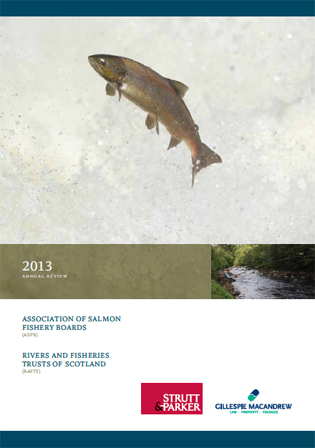 The RAFTS/ASFB Annual Conference, now firmly established as Scotland’s premier wild fisheries event, took place at Battleby on March 21. The programme – under the title “Catchment if you can: is Fisheries management more effective when catchment based?” – focussed on the issues and challenges of management on a catchment scale.
The RAFTS/ASFB Annual Conference, now firmly established as Scotland’s premier wild fisheries event, took place at Battleby on March 21. The programme – under the title “Catchment if you can: is Fisheries management more effective when catchment based?” – focussed on the issues and challenges of management on a catchment scale.
Callum Sinclair, Director of RAFTS said: “For several years, our spring conference, now jointly convened by RAFTS and ASFB, has been a pivotal event in the fisheries calendar. This provides an opportunity to present the positive contributions that Fishery Trusts and District Salmon Fishery Boards make individually and collaboratively to fisheries and environmental management and protection.”
Dr Alan Wells, Policy and Planning Director of ASFB welcomed the event, adding. “The schedule of presentations, with a range of speakers within and out with our network, included changes in run-timing of grilse, salmon production in relation to a river’s carrying capacity, hydro-power abstraction, biosecurity, prioritising barrier removal, Gyrodactylus salaris control, river restoration and genetic tool development.”
The conference will also mark the launch of the 2013 ASFB and RAFTS Annual Review and Factsheet, which highlight the important contribution and role of Fishery Boards and Fishery Trusts in the management of Scotland’s freshwater fisheries. The review features a wide variety of material including articles on aquaculture, barrier removal, delays in the run-timing of grilse, the Upper Dee scheme, access to salmon fishing, bailiffing, the impact of hydro schemes as well as comprehensive river reports from across Scotland. The Review, sponsored by Strutt & Parker and Gillespie MacAndrew, is now available online and in hard copy.
Callum Sinclair, Director of RAFTS, commented: “The network of Fishery Trusts now generates £2.71m from private and grant sources in addition to the £1M+ raised annually by RAFTS for the work of Trusts. In the last year alone 82 km of riparian habitat has been restored or improved and access for migratory fish to 66 km of river has been made possible through the removal or easement of man-made barriers.”
Mr Sinclair added: “National collections of work, developed by RAFTS, are now being delivered by Fishery Trusts – for example the Fishery Management Planning and the Biosecurity and Invasive Non-Native Species (INNS) Programmes. The INNS programme, tackling invasive non-native species such as American signal crayfish, mink and a range of alien riparian plants has itself has secured more than £5M of funding for practical work in the past three years. Trusts also complete a range of other activities which support wider fisheries and environmental management objectives including the delivery of local education programmes which have engaged tens of thousands of children across Scotland and made an important contribution to our societal understanding of the environment, freshwaters and fish.”
Dr Alan Wells, Policy and Planning Director of ASFB, said: “These documents underline the vital role that District Salmon Fishery Boards, working in partnership with Fishery Trusts, play in managing our rivers and lochs. Not only do Boards manage virtually all of Scotland’s salmon and sea trout fisheries, they do so at no cost to the public purse – Boards are principally financed by fishery owners to the tune of £4.15m. Boards have powers to appoint water bailiffs to enforce salmon fisheries legislation in Scotland. Over 350 water bailiffs who are in the frontline in enforcing Scotland’s salmon fisheries legislation have successfully undergone formal accreditation and they play a vital role, in partnership with Police wildlife crime officers, in tackling the illegal killing of wild salmon and sea trout.”
More Information on the 2013 Annual Conference
The 2013 Annual Review
The 2013 Factsheet
